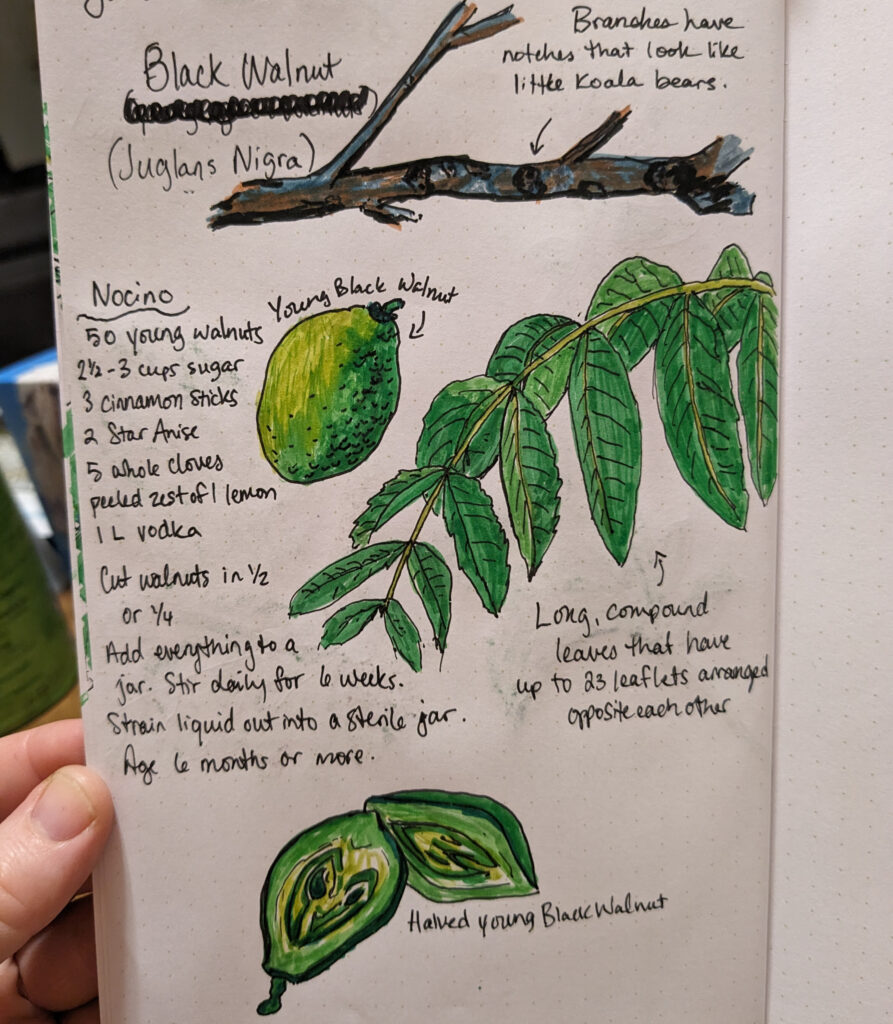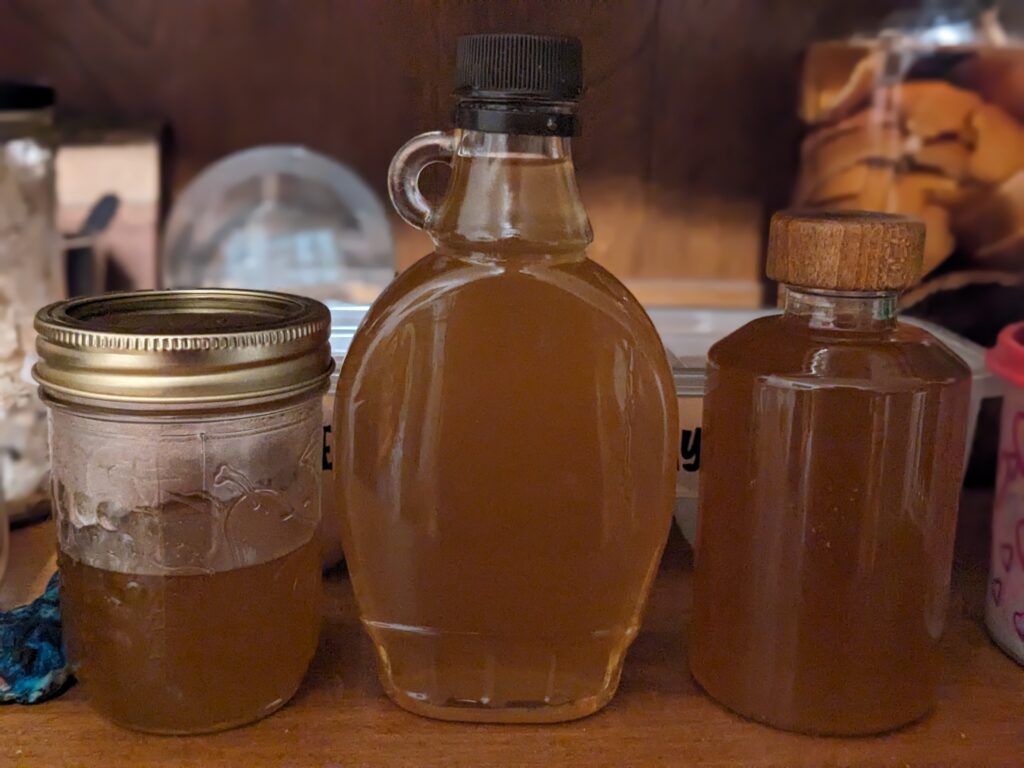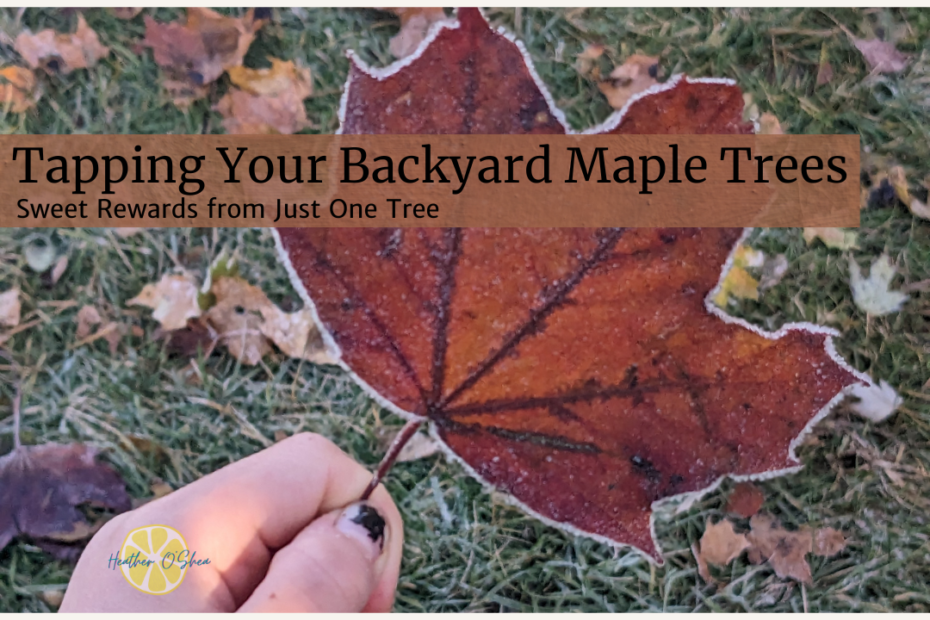*This post may contain affiliate links and I may earn a small commission when you click on the links at no additional cost to you. As an Amazon Affiliate I earn from qualifying purchases. You can read my full affiliate disclosure here.
Yes, You Can Tap That Tree!
If you have a maple tree in your yard—even if it’s just one and even if it’s not a sugar maple—you can tap it for syrup! Many people assume you need a whole sugarbush to make it worth the effort, but even a single tree can provide enough sap to give you a taste of homemade, golden maple goodness. And the best part? It’s a fantastic way to connect with nature, your family, and even your neighbors.
What Kind of Trees Can You Tap?
Sugar maples are the gold standard because their sap has the highest sugar content, meaning less boiling to get syrup. But red maples, silver maples, and even box elders (a maple cousin) will also give you sap that can be turned into syrup. The only real difference is that you may need to boil a little longer to concentrate the sugars.

Fun Fact: Tap Into More Than Just Maple!
Did you know that maple trees aren’t the only sappy stars in the backyard tap dance? Birch and black walnut trees can also be tapped for syrup, offering unique flavors that might surprise your taste buds!
- Birch Syrup: It’s got a distinct, bold flavor reminiscent of molasses or balsamic vinegar. While it takes more sap (about 100 gallons for 1 gallon of syrup), it’s a gourmet delight worth the effort!
- Black Walnut Syrup: This syrup brings a nutty, buttery punch with a hint of vanilla. Though you’ll need around 50-60 gallons of sap per gallon of syrup, it’s a rare treat that can elevate your breakfast game to new heights.
The Basic Tools You Need
You don’t need fancy commercial equipment to get started—just a few simple tools:
- Drill with a 7/16-inch or 5/16-inch bit (depending on your spile size)
- Spile (that’s the “tap” part) – Available online or at places like Peavy Mart
- Food-grade tubing or bucket – To collect the sap
- Lid or cover – To keep debris out of your sap
- Large pot and heat source – For boiling down the sap
- Candy thermometer – To check when the syrup is done (final boiling temp around 219°F/104°C)
How to Tap a Tree
- Find a good spot – Choose a healthy tree at least 12 inches in diameter.
- Drill a hole – About 1.5 inches deep, drill straight into the side, on the south-facing side of the tree if possible.
- Insert the spile – Gently tap it in with a hammer until snug. Do NOT use the butt (aka the battery) of your drill instead, even if you forgot the hammer inside and the tap is already dripping and you don’t want to waste any. Just don’t. Go get the hammer. Trust me.
- Attach a collection container – Either hang a bucket from the spile or use tubing into a covered container.
- Wait for the sap to flow – It will drip out when temperatures rise above freezing during the day and drop below freezing at night.
When to Tap Your Trees: Timing is Everything!
Timing is crucial when it comes to tapping your trees. Typically, the best time to tap maple trees is late winter to early spring when the temperatures fluctuate between freezing at night and thawing during the day. This temperature dance encourages sap flow, making it prime time for tapping.
For most regions, this sweet spot usually hits around February to March, but it can vary based on your local climate. Keep an eye on the weather forecasts and look for those magical days when the thermometer dips below freezing at night and rises above during the day.
And here’s a fun tidbit: while maple trees are the headliners, if you’re feeling adventurous, you can also tap birch trees a bit later in the season, typically in early spring when temperatures are consistently warmer.
Sap-to-Syrup Ratio: How Much Sap Do You Need?
On average, it takes about 40 gallons of sap to make 1 gallon of syrup (sugar maples). If you’re tapping a silver or red maple, you might need closer to 50 gallons per gallon of syrup. Even if you only get a pint or two, it’s worth it for the experience and flavor!

The Benefits of Backyard Maple Syrup
- It’s pure and natural – No additives, just straight-up tree magic.
- You’ll taste the difference – The complex, caramel-like flavors of homemade syrup beat store-bought every time.
- It’s a hands-on, rewarding activity – Great for kids, families, and anyone who loves DIY projects.
- It builds community – Why not ask your neighbors if they’d like to tap their trees too? You can pool your sap and make it a fun weekend project.
Cautions & Considerations
- Don’t overtap – A tree should have only one tap if it’s 12-18 inches in diameter, two if it’s larger.
- Use food-safe collection gear – Avoid anything that could leach chemicals into your sap.–No hardware store buckets! Food grade only. Tip: you can often find cheap food grade buckets with lids at wine making stores!
- Monitor your boil – Syrup can quickly go from perfect to burnt if left unattended.
- Be mindful of bacteria – Sap can spoil if left too long in warm weather, so store and process it promptly.
Make It a Community Effort!
Tapping trees can be a wonderful way to engage with neighbors. Many people don’t realize their maple trees are tappable! Offer to share syrup if they let you tap their trees, or make it a neighborhood event. You could even set up a community sap boil, making it a social gathering with pancakes, laughter, and learning.
Ready to Tap Your First Tree?
Now’s the time! Gather your supplies, watch the weather, and get ready to enjoy one of nature’s sweetest gifts. Whether you get a gallon of syrup or just a jar, it’s an experience worth savoring.
Have you tapped your own trees before? Share your experiences or ask questions in the comments below!
